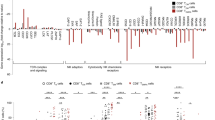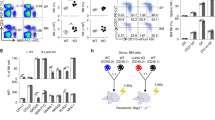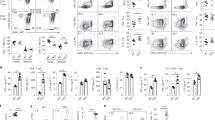Abstract
The adaptors SAP, EAT-2 and ERT are specific to cells of the immune system and belong to the SAP family. All three are expressed in natural killer (NK) cells. Here we examined the global function of the SAP family using mice lacking SAP, EAT-2 and ERT. These adaptors acted together in a mechanism that was essential for the elimination of hematopoietic but not nonhematopoietic cells by NK cells. This function was mediated by many receptors of the SLAM family on NK cells that were engaged by ligands found solely on hematopoietic cells. In the absence of SAP-related adaptors, SLAM receptors lost their activating function and became inhibitory receptors that repressed other activating receptors, such as NKG2D. Hence, the SAP family is essential for the elimination of unwanted hematopoietic cells by NK cells.
This is a preview of subscription content, access via your institution
Access options
Subscribe to this journal
Receive 12 print issues and online access
$209.00 per year
only $17.42 per issue
Buy this article
- Purchase on Springer Link
- Instant access to full article PDF
Prices may be subject to local taxes which are calculated during checkout








Similar content being viewed by others
References
Lanier, L.L. NK cell recognition. Annu. Rev. Immunol. 23, 225–274 (2005).
Raulet, D.H. Roles of the NKG2D immunoreceptor and its ligands. Nat. Rev. Immunol. 3, 781–790 (2003).
Guerra, N. et al. NKG2D-deficient mice are defective in tumor surveillance in models of spontaneous malignancy. Immunity 28, 571–580 (2008).
Gazit, R. et al. Lethal influenza infection in the absence of the natural killer cell receptor gene Ncr1. Nat. Immunol. 7, 517–523 (2006).
Wang, D. et al. Phospholipase Cγ2 is essential in the functions of B cell and several Fc receptors. Immunity 13, 25–35 (2000).
Gilfillan, S. et al. DNAM-1 promotes activation of cytotoxic lymphocytes by nonprofessional antigen-presenting cells and tumors. J. Exp. Med. 205, 2965–2973 (2008).
Iguchi-Manaka, A. et al. Accelerated tumor growth in mice deficient in DNAM-1 receptor. J. Exp. Med. 205, 2959–2964 (2008).
Veillette, A. Immune regulation by SLAM family receptors and SAP-related adaptors. Nat. Rev. Immunol. 6, 56–66 (2006).
Ma, C.S., Nichols, K.E. & Tangye, S.G. Regulation of cellular and humoral immune responses by the SLAM and SAP families of molecules. Annu. Rev. Immunol. 25, 337–379 (2007).
Engel, P., Eck, M.J. & Terhorst, C. The SAP and SLAM families in immune responses and X-linked lymphoproliferative disease. Nat. Rev. Immunol. 3, 813–821 (2003).
Tangye, S.G., Phillips, J.H., Lanier, L.L. & Nichols, K.E. Functional requirement for SAP in 2B4-mediated activation of human natural killer cells as revealed by the X-linked lymphoproliferative syndrome. J. Immunol. 165, 2932–2936 (2000).
Nakajima, H. et al. Patients with X-linked lymphoproliferative disease have a defect in 2B4 receptor-mediated NK cell cytotoxicity. Eur. J. Immunol. 30, 3309–3318 (2000).
Benoit, L., Wang, X., Pabst, H.F., Dutz, J. & Tan, R. Defective NK cell activation in X-linked lymphoproliferative disease. J. Immunol. 165, 3549–3553 (2000).
Bottino, C. et al. NTB-A, a novel SH2D1A-associated surface molecule contributing to the inability of natural killer cells to kill Epstein-Barr virus-infected B cells in X-linked lymphoproliferative disease. J. Exp. Med. 194, 235–246 (2001).
Parolini, S. et al. X-linked lymphoproliferative disease. 2B4 molecules displaying inhibitory rather than activating function are responsible for the inability of natural killer cells to kill Epstein-Barr virus-infected cells. J. Exp. Med. 192, 337–346 (2000).
Bloch-Queyrat, C. et al. Regulation of natural cytotoxicity by the adaptor SAP and the Src-related kinase Fyn. J. Exp. Med. 202, 181–192 (2005).
Roncagalli, R. et al. Negative regulation of natural killer cell function by EAT-2, a SAP-related adaptor. Nat. Immunol. 6, 1002–1010 (2005).
Cruz-Munoz, M.E., Dong, Z., Shi, X., Zhang, S. & Veillette, A. Influence of CRACC, a SLAM family receptor coupled to the adaptor EAT-2, on natural killer cell function. Nat. Immunol. 10, 297–305 (2009).
Nichols, K.E. et al. Regulation of NKT cell development by SAP, the protein defective in XLP. Nat. Med. 11, 340–345 (2005).
Chung, B., Aoukaty, A., Dutz, J., Terhorst, C. & Tan, R. Signaling lymphocytic activation molecule-associated protein controls NKT cell functions. J. Immunol. 174, 3153–3157 (2005).
Pasquier, B. et al. Defective NKT cell development in mice and humans lacking the adapter SAP, the X-linked lymphoproliferative syndrome gene product. J. Exp. Med. 201, 695–701 (2005).
Bryceson, Y.T. & Long, E.O. Line of attack: NK cell specificity and integration of signals. Curr. Opin. Immunol. 20, 344–352 (2008).
Degli-Esposti, M.A. & Smyth, M.J. Close encounters of different kinds: dendritic cells and NK cells take centre stage. Nat. Rev. Immunol. 5, 112–124 (2005).
Bryceson, Y.T., March, M.E., Barber, D.F., Ljunggren, H.G. & Long, E.O. Cytolytic granule polarization and degranulation controlled by different receptors in resting NK cells. J. Exp. Med. 202, 1001–1012 (2005).
Habu, S. et al. In vivo effects of anti-asialo GM1. I. Reduction of NK activity and enhancement of transplanted tumor growth in nude mice. J. Immunol. 127, 34–38 (1981).
Lee, K.M. et al. 2B4 acts as a non-major histocompatibility complex binding inhibitory receptor on mouse natural killer cells. J. Exp. Med. 199, 1245–1254 (2004).
Zhong, M.C. & Veillette, A. Control of T lymphocyte signaling by ly108, a signaling lymphocytic activation molecule family receptor implicated in autoimmunity. J. Biol. Chem. 283, 19255–19264 (2008).
Mathew, P.A. et al. Cloning and characterization of the 2B4 gene encoding a molecule associated with non-MHC-restricted killing mediated by activated natural killer cells and T cells. J. Immunol. 151, 5328–5337 (1993).
Bouchon, A., Cella, M., Grierson, H.L., Cohen, J.I. & Colonna, M. Cutting edge: activation of NK cell-mediated cytotoxicity by a SAP-independent receptor of the CD2 family. J. Immunol. 167, 5517–5521 (2001).
Eissmann, P. et al. Molecular basis for positive and negative signaling by the natural killer cell receptor 2B4 (CD244). Blood 105, 4722–4729 (2005).
Veillette, A., Latour, S. & Davidson, D. Negative regulation of immunoreceptor signaling. Annu. Rev. Immunol. 20, 669–707 (2002).
Guo, H., Samarakoon, A., Vanhaesebroeck, B. & Malarkannan, S. The p110δ of PI3K plays a critical role in NK cell terminal maturation and cytokine/chemokine generation. J. Exp. Med. 205, 2419–2435 (2008).
Awasthi, A. et al. Deletion of PI3K-p85α gene impairs lineage commitment, terminal maturation, cytokine generation and cytotoxicity of NK cells. Genes Immun. 9, 522–535 (2008).
Kim, N. et al. The p110δ catalytic isoform of PI3K is a key player in NK-cell development and cytokine secretion. Blood 110, 3202–3208 (2007).
Regunathan, J. et al. Differential and nonredundant roles of phospholipase Cγ2 and phospholipase Cγ1 in the terminal maturation of NK cells. J. Immunol. 177, 5365–5376 (2006).
Caraux, A. et al. Phospholipase C-γ2 is essential for NK cell cytotoxicity and innate immunity to malignant and virally infected cells. Blood 107, 994–1002 (2006).
Velikovsky, C.A. et al. Structure of natural killer cell receptor 2B4 (CD244) bound to its ligand, CD48. Immunity 27, 572–584 (2007).
Cao, E. et al. NTB-A receptor crystal structure: insights into homophilic interactions in the signaling lymphocytic activation molecule receptor family. Immunity 25, 559–570 (2006).
Wahle, J.A. et al. Inappropriate recruitment and activity by the Src homology region 2 domain-containing phosphatase 1 (SHP1) is responsible for receptor dominance in the SHIP-deficient NK cell. J. Immunol. 179, 8009–8015 (2007).
Wang, J.W. et al. Influence of SHIP on the NK repertoire and allogeneic bone marrow transplantation. Science 295, 2094–2097 (2002).
Sivori, S. et al. Early expression of triggering receptors and regulatory role of 2B4 in human natural killer cell precursors undergoing in vitro differentiation. Proc. Natl. Acad. Sci. USA 99, 4526–4531 (2002).
Vaidya, S.V. & Mathew, P.A. Of mice and men: Different functions of the murine and human 2B4 (CD244) receptor on NK cells. Immunol. Lett. 105, 180–184 (2006).
Castro, A.G. et al. Molecular and functional characterization of mouse signaling lymphocytic activation molecule (SLAM): differential expression and responsiveness in Th1 and Th2 cells. J. Immunol. 163, 5860–5870 (1999).
Sandrin, M.S. et al. Isolation and characterization of cDNA clones for Humly9: the human homologue of mouse Ly9. Immunogenetics 43, 13–19 (1996).
Davidson, D., Viallet, J. & Veillette, A. Unique catalytic properties dictate the enhanced function of p59fynT, the hemopoietic cell-specific isoform of the Fyn tyrosine protein kinase, in T cells. Mol. Cell. Biol. 14, 4554–4564 (1994).
Lemay, S., Davidson, D., Latour, S. & Veillette, A. Dok-3, a novel adapter molecule involved in the negative regulation of immunoreceptor signaling. Mol. Cell. Biol. 20, 2743–2754 (2000).
Lutz, M.B. et al. An advanced culture method for generating large quantities of highly pure dendritic cells from mouse bone marrow. J. Immunol. Methods 223, 77–92 (1999).
Conner, D.A. in Curr. Protoc. Mol. Biol. (eds. Ausubel, F.M. et al.) Ch. 23, Unit 23.2, 1–7 (John Wiley and Sons, Toronto, 2001).
Veillette, A. et al. SAP expression in T cells, not in B cells, is required for humoral immunity. Proc. Natl. Acad. Sci. USA 105, 1273–1278 (2008).
Veillette, A., Bookman, M.A., Horak, E.M. & Bolen, J.B. The CD4 and CD8 T cell surface antigens are associated with the internal membrane tyrosine-protein kinase p56lck. Cell 55, 301–308 (1988).
Acknowledgements
We thank D. Davidson for critical reading of the manuscript. Supported by the Canadian Institutes of Health Research (Veillette laboratory and Z.D.), the Canadian Cancer Society Research Institute (Veillette laboratory and M.-E.C.-M.), the Howard Hughes Medical Institute (Veillette laboratory and A.V.), the Institut National de la Santé et de la Recherche Médicale (Latour laboratory), the Agence Nationale de la Recherche (Latour laboratory), the Ligue Nationale Contre le Cancer–Ile de France (Latour laboratory), the Clinical Research Institute of Montreal (Z.D.), the Centre National de la Recherche Scientifique (S.L.) and Canada Research Chair Program (A.V.).
Author information
Authors and Affiliations
Contributions
Z.D. conceived of the research, did experiments, analyzed data and wrote the manuscript; M.-E.C.-M., R.C. and M.-C.Z. conceived of the research and generated critical reagents; S.L. did research, analyzed data and generated critical reagents; and A.V. conceived of the research, generated reagents, analyzed data and wrote the manuscript.
Corresponding author
Supplementary information
Supplementary Text and Figures
Supplementary Figures 1–9 (PDF 409 kb)
Rights and permissions
About this article
Cite this article
Dong, Z., Cruz-Munoz, ME., Zhong, MC. et al. Essential function for SAP family adaptors in the surveillance of hematopoietic cells by natural killer cells. Nat Immunol 10, 973–980 (2009). https://doi.org/10.1038/ni.1763
Received:
Accepted:
Published:
Issue Date:
DOI: https://doi.org/10.1038/ni.1763
This article is cited by
-
Soluble SLAMF7 is a predictive biomarker for elotuzumab therapy
Leukemia (2020)
-
Soluble SLAMF7 promotes the growth of myeloma cells via homophilic interaction with surface SLAMF7
Leukemia (2020)
-
Serum cytokine dependent hematopoietic cell linker (CLNK) as a predictor for the duration of illness in type 2 diabetes mellitus
Journal of Diabetes & Metabolic Disorders (2020)
-
NK cell recognition of hematopoietic cells by SLAM-SAP families
Cellular & Molecular Immunology (2019)
-
Synergized regulation of NK cell education by NKG2A and specific Ly49 family members
Nature Communications (2019)



